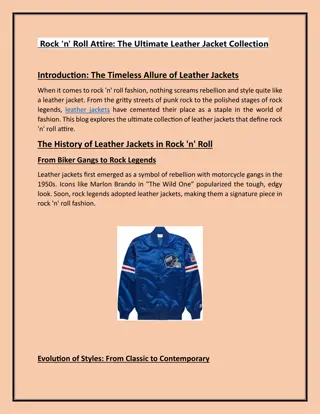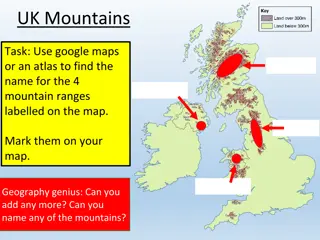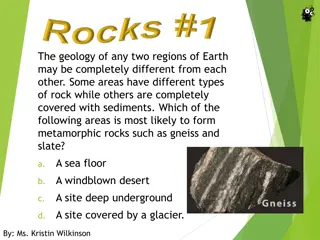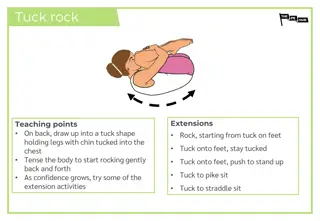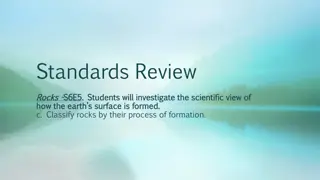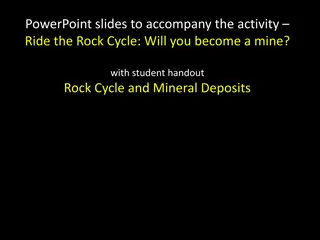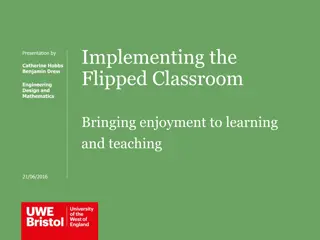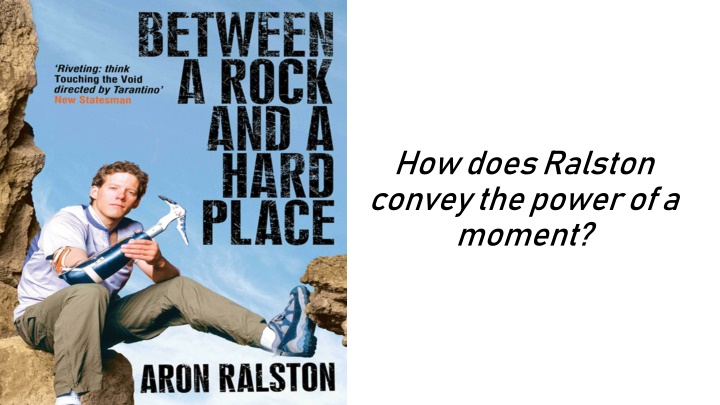
Conveying the Power of a Moment: Aron Ralston's Climbing Experience
Explore how Aron Ralston, an experienced climber, conveys the intensity of pivotal moments through his detailed descriptions, expert climbing techniques, and emotional journey amidst challenging situations while navigating remote canyons. Witness the powerful narrative of Ralston's gripping ascent and the fateful events that tested his courage and resilience in the face of adversity.
Download Presentation

Please find below an Image/Link to download the presentation.
The content on the website is provided AS IS for your information and personal use only. It may not be sold, licensed, or shared on other websites without obtaining consent from the author. If you encounter any issues during the download, it is possible that the publisher has removed the file from their server.
You are allowed to download the files provided on this website for personal or commercial use, subject to the condition that they are used lawfully. All files are the property of their respective owners.
The content on the website is provided AS IS for your information and personal use only. It may not be sold, licensed, or shared on other websites without obtaining consent from the author.
E N D
Presentation Transcript
How does Ralston convey the power of a moment?
Who is Aron Ralston? Aron Rolston was born in the USA in 1975. After studying mechanical engineering at Carnegie Mellon University in Pittsburgh, he moved to Colorado to continue mountaineering, which had become his major interest. In 2003, the accident which changed his life took place. Since then, his best-selling book has been made into an Oscar-nominated film 127 Hours , by Danny Boyle, and he has continued with mountain climbing and media appearances. In April 2003, while hiking in Canyonlands National Park in Utah, Ralston was trapped by a rockfall. After five days, on the point of death, he was able to free himself from a narrow canyon by amputating his right arm at the wrist using a small hunting knife. After stumbling upon a group of hikers he was finally rescued. The extract is a narration of a single, dramatic episode. Aron Ralston is hiking in a remote part of the United States, and moving through a narrow gulley. The passage gives detailed descriptions of the way that Ralston normally tackles such spaces, and his climbing techniques for doing so, but as he hangs from a boulder temporarily, it shifts and begins to move. He falls and the boulder crushes and traps his hand against the side of the canyon. The extract describes very intensely his pain, and his emotions faced with this predicament. It ends with Ralston trying to free his hand by moving the boulder, but he is unable to do so.
Noun phrase: maybe eleven or twelve feet high experienced and so can estimate the length of the drop 1. Ralston is an experienced climber adjective: another is used to approaching drop-offs Short sentence confident tone. Declarative: It gives the space a short tunnel His careful assessment of the situation and attention to detail reveals his expertise. 1 2 3 4 5 6 7 8 9 10 I come to another drop-off. This one is maybe eleven or twelve feet high, a foot higher and of a different geometry than the overhand I descended ten minutes ago. Another refrigerator chockstone is wedged between the walls, ten feet downstream from and at the same height as the ledge. It gives the space below the drop-off the claustrophobic feel of a short tunnel. Instead of the walls widening after the drop-off, or opening into a bowl at the bottom of the canyon, here the slot narrows to a consistent three feet across at the lip of the drop-off and continues at that width for fifty feet down the canyon. Semantic field: descended, chockstone, ledge, drop-off, tunnel, bowl, slot, counterpressure, crevice, friction, stemming, chimneying Words all associated with climbing showing his knowledge and expertise. Tentative language: Maybe, sometimes, possible, as long as His careful assessment of the situation and weighing up shows his expertise 11 12 13 14 15 16 17 18 19 Sometimes in narrow passages like this one, it s possible for me to stem my body across the slot, with my feet and back pushing out in opposite directions against the walls. Controlling this counterpressure by switching my hands and feet on the opposing walls, I can move up or down the shoulder-width crevice fairly easily as long as the friction contact stays solid between the walls and my hands, feet and back. This technique is known as stemming or chimneying; you can imagine using it to climb up the inside of a chimney.
First person, factual, sequence of events: If I can canyon floor This is like an internal monologue / stream of consciousness where he is talking us through the steps he needs to take. 1. Ralston is an experienced climber: a slight problem to overcome Inciting incident (narrative structure): is a chockstone from the lip A moment occurs where something is obstructing the path 20 21 22 23 24 25 Just below the ledge where I m standing is a chockstone the size of a large bus tire, stuck fast in the channel between the walls, a few feet out from the lip. If I can step onto it, then I ll have a nine-foot height to descend, less than that of the first overhang. I ll dangle off the chockstone, then take a short fall onto the rounded rocks piled on the canyon floor. Tense: I ll dangle From present to future to indicate to us the approach he is going to take 26 27 28 29 30 31 32 33 34 35 Stemming across the canyon at the lip of the drop-off, with one foot and one hand on each of the walls, I traverse out to the chockstone. I press my back against the south wall and lock my left knee, which pushes my foot tight against the north wall. With my right foot, I kick at the boulder to test how stuck it is. It s jammed tightly enough to hold my weight. I lower myself from the chimneying position and step onto the chockstone. It supports me but teeters slightly. After confirming that I don t want to chimney down from the chockstone s height, I squat and grip the rear of the lodged boulder, turning to face back upcanyon. Sliding my belly. Semantic field: chockstone, overhang, canyon, stemming Words all associated with climbing showing his knowledge and expertise. Verbs: stemming, traverse, press, lock, kick, lower, step, squat Sequence of movements he is making. Shows he knows what he is doing 36 37 over the front edge, I can lower myself and hang from my fully extended arms, akin to climbing down from the roof of a house. Sequence of short, factual sentences: I press house Factual account of how he is going to approach the boulder.
Technical jargon: torque rotational force 2. Danger appears in a moment Personification stone responds as if it has his life Adverb: instantly, instinctively His instincts tell him he has a problem. Two adverbs close together tell us things start to move at a fast past and he has to respond quickly 38 39 40 41 42 43 44 45 As I dangle, I feel the stone respond to my adjusting grip with a scraping quake as my body s weight applies enough torque to disturb it from its position. Instantly, I know this is trouble, and instinctively, I let go of the rotating boulder to land on the round rocks below. When I look up, the backlit chockstone falling toward my head consumes the sky. Fear shoots my hands over my head. I can t move backward or I ll fall over a small ledge. My only hope is to push off the falling rock and get my head out of its way. Personification: chockstone falling toward my head consumes the sky As it gets closer, it blocks Ralston s field of vision Short sentence: Fear shoots my hands over my head As the boulder falls closer, he becomes scared. This is clearly juxtaposed to the calm and skillful manner from the start of the piece. Noun phrase: My only hope Sounds desperate and dangerous.
Alliteration: dilates, dreaming, decelerate whilst everything is happening fast, they appear to be happening slowly to Ralston 3. The moment of impact Verb phrase time dilates time slows down this is reinforced by the sentence structure. Each clause is longer than the previous one to reflect slowing down of time, three clauses, three seconds. 46 47 48 49 50 51 52 53 54 The next three seconds play out at a tenth of their normal speed. Time dilates, as if I m dreaming, and my reactions decelerate. In slow motion: the rock smashes my left hand against the south wall; my eyes register the collision, and I yank my left arm back as the rock ricochets; the boulder then crushes my right hand and ensnares my right arm at the waist, palm in, thumb up, fingers extended; the rock slides another foot down the wall with my arm in tow, tearing the skin off the lateral side of my forearm. Then silence. Short sentence: Then silence After the lengthy description of the action, this short sentence juxtaposes that for dramatic impact. Readers left wondering until next paragraph. Verbs: smashes, yank, ricochets, crushes, tearing Aggressive verbs to suggest the impact of the rock against Ralston s body Verb: register juxtaposed against the aggressive verbs, a very passive verb to describe Ralston taking stock of what he can see scientific and unfeeling in manner.
Clause: I stare .canyon wall The verb stare helps to separate his mind and what is physically happening to him. 4. Moment of pain and shock Clause: my nervous system s pain response overcomes the initial shock Quite detached, scientific response. Rational side of Ralston. Verb paralyzes his disbelief at what has happened freezes him Temporal marker: Within moments Actions are happening quickly 55 56 57 58 59 60 61 62 My disbelief paralyzes me temporarily as I stare at the sight of my arm vanishing into an implausibly small gap between the fallen boulder and the canyon wall. Within moments, my nervous system s pain response overcomes the initial shock. Good God, my hand. The flaring agony throws me into a panic. I grimace and growl My mind commands my body, Get your hands out of there! I yank my arm three times in a na ve attempt to pull it out. But I m stuck. Noun phrase: Good God Juxtaposed with rational side. Emotional reaction. Alliteration: grimace and growl Gutteral sounds Noun phrase: flaring agony Metaphor of arm being on fire. The pain is starting to increase. Short sentence: But I m stuck Conjunction but presents juxtaposition against pain he is feeling and desire to get out versus being physically unable to do so. Short sentence reveals next problem he faces. Adjective: naive Juxtaposed with experience from earlier on. Direct speech: Get your hands out of there Combined with exclamation mark speed needed against situation. Mind is going into survival mode Verb: Yank Attempt to get his arms out. Physically aggressive movement. Verb: Panic Losing rational, scientific side as he is overcome with pain.
Verb phrase: searing hot echoes flaring agony and the pain he is experiencing. 4. Cliffhanger ending Verb tweaking to pinch painfully, more up-to-date meaning painful and disorientating symptoms of hard drug withdrawl. 63 64 65 66 67 68 69 70 71 72 73 74 Anxiety has my brain tweaking; searing-hot pain shoots from my wrist up my arm. I m frantic, and I cry out My desperate brain conjures up a probably apocryphal story in which an adrenaline- stoked mom lifts an overturned car to free her baby. I d give it even odds that it s made up, but I do know for certain that right now, while my body s chemicals are raging at full flood, is the best chance I ll have to free myself with brute force. I shove against the large boulder, heaving against it, pushing with my left hand, lifting with my knees pressed under the rock. I get good leverage with the aid of a twelve- inch shelf in front of my feet. Standing on that, I brace my thighs under the boulder and thrust upward repeatedly, grunting, Come on move! Nothing. Compound sentence: I m frantic and I cry out Simultaneous actions mind and physical. Contrasts with rational skilled voice from earlier. Reinforced by adjective desperate Analogy: adrenaline stoked mom .free her baby Gives a reader the sense of the scale of the task ahead of him. Listing of verbs: shove, heaving, pushing, brace, thrust All attempts to free his hand. Direct speech: Come on move! Urging himself. Exclamation mark shows his sense of panic. Imperative language commanding himself. Short sentence: Nothing Readers are left on a cliffhanger in terms of learning what happens
How does Ralston convey the power of a moment? Isolated moment in time Calm, skilled start One shift of a boulder changes everything Simultaneous moments colliding Reactions in the moment Shift from skilled and experienced to one of panic and tension Left hanging literally and figuratively


